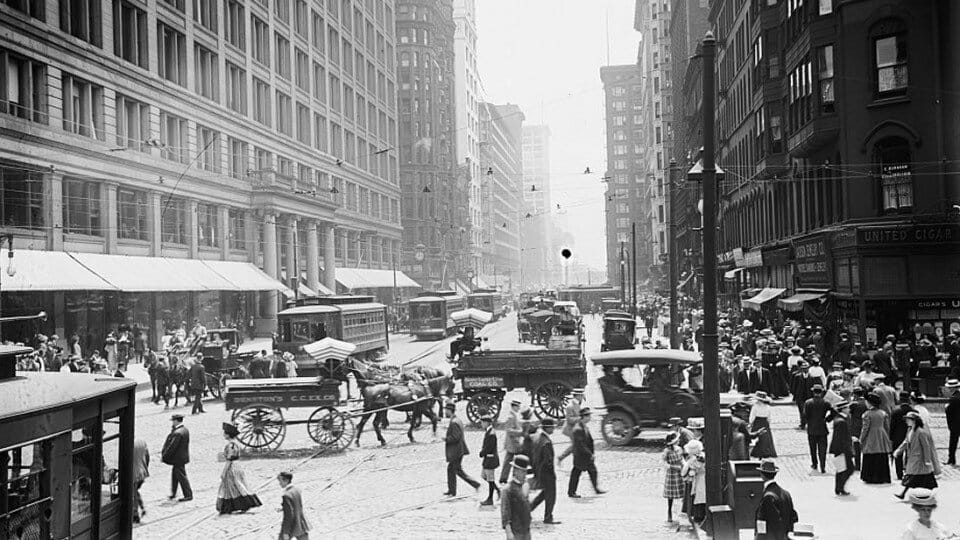

Time traveling to 1908 Chicago
It’s been 108 years since the Cubs won the World Series. We take a look back at 1908 Chicago to see a glimpse of the city, its people and the architecture.
It’s been 108 years since the Cubs won the World Series. We take a look back at 1908 Chicago to see a glimpse of the city, its people and the architecture.
by Marko Dumlija, Research Intern and Jen Masengarb, Director of Interpretation and Research
A GROWING, CHANGING CITY
In 1908, Chicago was adjusting to a massive influx of immigrants and migrants, as well as to the residents of surrounding townships that the city of Chicago had annexed in the late 19th century. From the city’s 1837 founding up to the early 20th century, the city’s population more than doubled every 10 years. And by 1908, Chicago had approximately two million people, 34 percent of whom were foreign born. Industries such as meat, lumber, grain, steel, railroads and catalog businesses across the city fueled the region’s economy. And women rapidly entered the white collar work force in large numbers in the early 20th century. In 1908, roughly 80 percent of the city’s typists and stenographers were women.
CHICAGO ARCHITECTURE IN 1908
The Ford Model T was introduced in the fall of 1908, but you would have likely seen many more horse drawn carriages and cable cars than automobiles on Chicago’s streets during the World Series. Several architectural icons were constructed around the time of the Cubs’ big win. Along State Street, the new Marshall Field and Company buildings (1902, 1907) launched a glamorous era in department store design. On South Michigan Avenue, the gleaming white terra cotta of the Railway Exchange Building (1904) stood next to Orchestra Hall (1905), a new home for the Chicago Symphony. And on the west side, Louis Sullivan designed Holy Trinity Russian Orthodox Cathedral (1903) combining organic ornament with religious iconography.
MAKING “NO LITTLE PLANS”
Was Daniel Burnham a Cubs fan? We have no idea. But we do know that while the Cubs were busy trouncing the Detroit Tigers in the fall of 1908, the city’s most well-known and influential architect/city planner was hard at work too. Working out of the penthouse in the newly-constructed Railway Exchange Building, Daniel Burnham and his colleague Edward Bennett were finishing up the Plan of Chicago which would be released in July 1909. Burnham and Bennett envisioned a ribbon of public lakefront parks, wider streets, grand diagonal boulevards and large Neo-Classical public buildings. Their design also included Navy Pier and a double-decker street system along the Chicago River that would later become Wacker Drive.
DREAMING OF ICONS
So much of Chicago’s historic infrastructure and architecture that we take for granted was not yet built in 1908. Architect Frank Lloyd Wright’s daringly-designed Robie House in Hyde Park was under construction. Edward Brennan’s plan for renumbering the entire city’s addresses was approved by the city council in 1908, but it didn’t take effect until the next year. None of Chicago’s 80,000 bungalows were constructed yet—those would come after World War I. And some of this city’s most striking early 20th century icons were just a dream. The famous Wrigley Building (1919), Tribune Tower (1923) and the Michigan Avenue Bridge (1920, known today as the DuSable Bridge) were all several years away from being built.
WHERE IS WRIGLEYVILLE?
Perhaps one the most surprising things to consider is that when the Cubs won the World Series in 1908, historic Wrigley Field had not yet been constructed. The 1908 games were played at West Side Park, now the site of the UIC Medical Center, in the block bounded by Polk, Wood, Taylor and Wolcott streets. Wrigley Field, originally known at Weeghman Park, would not be built until 1914. Maps from the late 1890s in the area that would become “Wrigleyville” show an empty site at Clark and Addison—and without any “L” train tracks. The neighborhood contained only a handful of new greystones and Chicago two-flats. And the nearest bar was more than six blocks away. Ah, how times have changed.
